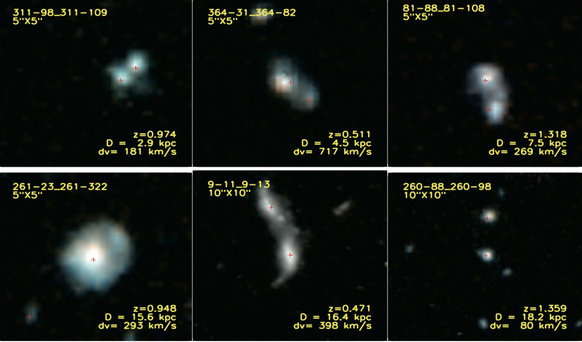An unprecedented sample of kinematically confirmed galaxy pairs
The merging of galaxies is one critical path of galaxy evolution, yet the incidence rate of galaxy pairs and their impact on galaxies' physical properties are far from being definite, for instance, will the impact of galaxy interaction vary in different epochs of the universe?
A new research study, led by Prof. Y.Sophia Dai from Chinese Academy of Sciences South America Center for Astronomy (CASSACA) at the National Astronomical Observatories of the Chinese Academy of Sciences (NAOC), provides fresh insights to whether and how the interaction of two galaxies affect their formation and evolution.
This research result has recently been published in The Astrophysical Journal.
"This is the first time that galaxy pairs at redshift ~ 1 have been kinematically confirmed for such a large statistical sample," said Prof. Y.Sophia Dai, who is the lead author of this work, "Based on a 6-year-endeavor of Hubble Space Telescope’s parallel grism survey, we have acquired spectra for more than 413 pair systems with two or more member galaxies, thus confirming their interacting nature."
Spectral features, such as the 'golden standard' star formation rate estimator, the Ha emission, cannot be easily observed by ground based telescopes for galaxies at z ~ 1 (i.e. ~ 7.8 Gyrback in time), as the water vapor in our atmosphere blocks most of the cosmic infrared light, where these emission lines are redshifted to for galaxies beyond our local universe.
This is no longer a problem using the Hubble Space Telescope, whose grism spectroscopy offers spectral coverages into the near-infrared regime, allowing detections of galaxies in the distant universe, and kinematical confirmation of galaxy pairs, by measuring on their precise spectroscopic redshifts (i.e. velocities).
With these unprecedented data, Prof. Dai and her collaborators constructed the largest sample of emission line galaxy pairs back dated to 7 billion years ago. They found that when two galaxies interact or merge, they will experience an increase of star formation rate by 40%-60%, suggesting interaction triggered galaxy growth. This level of enhancement is comparable to what was previously found in our local universe, indicating similar boost in the formation due to galaxy interactions.
Interestingly, contrary to the increased star growth, the activities in the galaxy center (i.e. the central supermassive black holes), do not seem to be significantly affected by the interaction. Actually, the percentage of galaxies with the most actively growing black holes, often referred to as active galactic nuclei (AGNs), is found to be the same in paired and isolated emission line galaxies.
Finally, the authors constrained the fraction of galaxies in pairs: as we go back in time, more and more emission lines galaxies are found in pairs, with a mild power-law slope of ~ 0.6.
"Looking into the future, with James Webb Space telescope (JWST), which we have already been awarded almost 700 hours in cycle 1,and with China's Space Station Telescope (CSST) that also offers grism spectroscopy, we would be able to identify even more kinematically confirmed emission line galaxy pairs to better understand their impact on galaxy formation," said Prof. Dai.

Fig.1: Examples of emission line galaxy pairs, with image taken with the Hubble Space Telescope Wide Field Camera 3. Various morphologies and separations are seen in this kinematically confirmed pair sample, the largest to date at z~1. (Credit: Y.Sophia Dai)
This paper can be accessed at https://iopscience.iop.org/article/10.3847/1538-4357/ac2f96